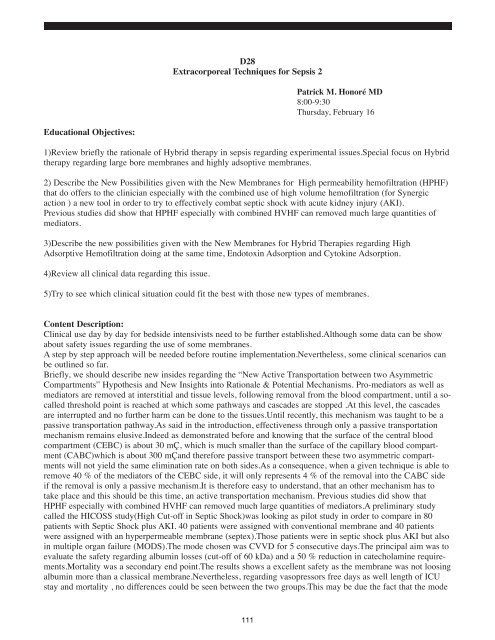ABSTRACTS from 16th International COnference on ... - CRRT Online
ABSTRACTS from 16th International COnference on ... - CRRT Online
ABSTRACTS from 16th International COnference on ... - CRRT Online
Create successful ePaper yourself
Turn your PDF publications into a flip-book with our unique Google optimized e-Paper software.
D28<br />
Extracorporeal Techniques for Sepsis 2<br />
Patrick M. H<strong>on</strong>oré MD<br />
8:00-9:30<br />
Thursday, February 16<br />
Educati<strong>on</strong>al Objectives:<br />
1)Review briefly the rati<strong>on</strong>ale of Hybrid therapy in sepsis regarding experimental issues.Special focus <strong>on</strong> Hybrid<br />
therapy regarding large bore membranes and highly adsoptive membranes.<br />
2) Describe the New Possibilities given with the New Membranes for High permeability hemofiltrati<strong>on</strong> (HPHF)<br />
that do offers to the clinician especially with the combined use of high volume hemofiltrati<strong>on</strong> (for Synergic<br />
acti<strong>on</strong> ) a new tool in order to try to effectively combat septic shock with acute kidney injury (AKI).<br />
Previous studies did show that HPHF especially with combined HVHF can removed much large quantities of<br />
mediators.<br />
3)Describe the new possibilities given with the New Membranes for Hybrid Therapies regarding High<br />
Adsorptive Hemofiltrati<strong>on</strong> doing at the same time, Endotoxin Adsorpti<strong>on</strong> and Cytokine Adsorpti<strong>on</strong>.<br />
4)Review all clinical data regarding this issue.<br />
5)Try to see which clinical situati<strong>on</strong> could fit the best with those new types of membranes.<br />
C<strong>on</strong>tent Descripti<strong>on</strong>:<br />
Clinical use day by day for bedside intensivists need to be further established.Although some data can be show<br />
about safety issues regarding the use of some membranes.<br />
A step by step approach will be needed before routine implementati<strong>on</strong>.Nevertheless, some clinical scenarios can<br />
be outlined so far.<br />
Briefly, we should describe new insides regarding the “New Active Transportati<strong>on</strong> between two Asymmetric<br />
Compartments” Hypothesis and New Insights into Rati<strong>on</strong>ale & Potential Mechanisms. Pro-mediators as well as<br />
mediators are removed at interstitial and tissue levels, following removal <str<strong>on</strong>g>from</str<strong>on</strong>g> the blood compartment, until a socalled<br />
threshold point is reached at which some pathways and cascades are stopped .At this level, the cascades<br />
are interrupted and no further harm can be d<strong>on</strong>e to the tissues.Until recently, this mechanism was taught to be a<br />
passive transportati<strong>on</strong> pathway.As said in the introducti<strong>on</strong>, effectiveness through <strong>on</strong>ly a passive transportati<strong>on</strong><br />
mechanism remains elusive.Indeed as dem<strong>on</strong>strated before and knowing that the surface of the central blood<br />
compartment (CEBC) is about 30 mÇ, which is much smaller than the surface of the capillary blood compartment<br />
(CABC)which is about 300 mÇand therefore passive transport between these two asymmetric compartments<br />
will not yield the same eliminati<strong>on</strong> rate <strong>on</strong> both sides.As a c<strong>on</strong>sequence, when a given technique is able to<br />
remove 40 % of the mediators of the CEBC side, it will <strong>on</strong>ly represents 4 % of the removal into the CABC side<br />
if the removal is <strong>on</strong>ly a passive mechanism.It is therefore easy to understand, that an other mechanism has to<br />
take place and this should be this time, an active transportati<strong>on</strong> mechanism. Previous studies did show that<br />
HPHF especially with combined HVHF can removed much large quantities of mediators.A preliminary study<br />
called the HICOSS study(High Cut-off in Septic Shock)was looking as pilot study in order to compare in 80<br />
patients with Septic Shock plus AKI. 40 patients were assigned with c<strong>on</strong>venti<strong>on</strong>al membrane and 40 patients<br />
were assigned with an hyperpermeable membrane (septex).Those patients were in septic shock plus AKI but also<br />
in multiple organ failure (MODS).The mode chosen was CVVD for 5 c<strong>on</strong>secutive days.The principal aim was to<br />
evaluate the safety regarding albumin losses (cut-off of 60 kDa) and a 50 % reducti<strong>on</strong> in catecholamine requirements.Mortality<br />
was a sec<strong>on</strong>dary end point.The results shows a excellent safety as the membrane was not loosing<br />
albumin more than a classical membrane.Nevertheless, regarding vasopressors free days as well length of ICU<br />
stay and mortality , no differences could be seen between the two groups.This may be due the fact that the mode<br />
111
















